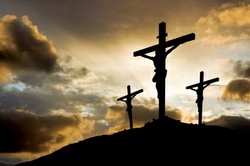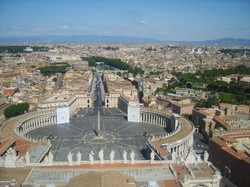One of the great errors of the enlightenment was to dismiss myth as simply fiction. Myths became synonymous with fairy tales and legends, devoid of historical truth and fit only for simple minds. But this is a fundamental error, as Tolkien told us, for myths are timeless tales which speak of fundamental human concerns and thus tell truths beyond the mere factual. For Karl Jung they reveal deep and profound truths about human existence, and as such they are means by which humans comprehend the sacred.

Christ and the Mythical Consciousness
by frankbeswick
Some important mythological themes seem to coalesce in the Jesus narrative
Mythology
C.S.Lewis, writing in Surprised by Joy, which details the long process of his conversion from atheism to Christianity, tells of a thought-provoking discussion that he had with an avowed atheist and hardened cynic. "Rum thing, all that stuff of Frazer's about a dying and rising God." he declared...."It almost looks as if it happened once." He was, of course, referring to Sir James Frazer's Golden Bough, which studied ancient religious thought to discern common patterns, and one pattern which seems to recur is the idea of a god who dies and rises again. This is not, however to say that pagan myths of dying and rising gods are identical with the Christ narrative, as the Osiris myth, for example, is set in cyclic time and embodies the cycle of the seasons, while the Christ narrative is set in linear time and in the context of Israel's salvation history, which renders it unique, but there is a definite parallel between the two.This is one of several mythological patterns that seem to be found in several religions.
The Enlightenment sneered at myth, dismissing it as mere fiction or fairy tales, but in doing so it shriveled its comprehension of the human mental world, depriving humans of a powerful source of emotional and spiritual stimulation that we are only in the last century or so attempting to redress. Certain Christian thinkers, such as Bultmann and Robinson, the Church of England Bishop who wrote Honest to God, bought into the Enlightenment project to the extent that they tried to demythologize Christian doctrine, as though myth were a burden rather than an integral component of religion.
There were other thinkers who took a different view. Lewis saw Christianity as myth that was true, while Tolkien called it true myth. Paul Ricoeur, a French scholar, was thought that the Bibel took myth and recast it as history. Mircea Eliade, a renowned scholar of world religions, believed that myth was essential to religion, and that mythology was part of the broader phenomenon of religious thought. For Karl Jung myth was an essential part of human thought arising from the collective unconsciousness, a layer of the mind shared between all humans. This collective unconscious contains a number of symbols that seem to transcend culture, and it is from these symbols that myths develop. One such symbol is the hero, whom the expert on mythology Joseph Campbell called the hero with a thousand faces, and heroic myths arise to detail the epic journey to destiny undertaken by this character. As these myths contain the deepest thoughts and aspirations of the human race, they are likely to be greatly significant in religious thinking, which is what they have been. Thus those who dismiss religious truths as myths are working on a defective understanding of myth, and those who set out to demythologize Christian doctrine are taking from it what makes it valuable.
Mythology
 | Mythology: Timeless Tales of Gods and Heroes Since its original publication by Little, Brown and Company in 1942, Edith Hamilton's Mythology has sold millions of copies throughout the world and established itself as a pere... |
 | The Student's Mythology: A Compendium of Greek, Roman, Egyptian, Assyrian, Persian, Hindoo, Chine... “The Student’s Mythology” is an excellent introduction into this area of studies. Its “Question/Answer” format makes it very accessible to anyone interested in world mythologies... |
Mythological themes in Christianity
Certain important mythological themes seem to coalesce in the Christ story. One is the myth of the hero. The hero sets out on a heroic journey to his destiny. The structure of Luke's Gospel from chapter 9:51 onwards sets Jesus on such a heroic journey towards his destiny in Jerusalem. Though Luke's account is not considered reliable as history, the broad pattern of Jesus' life was towards a high point in the sacred city. Luke's heroic journey is a literary device for showing the structure of Jesus' life. The heroic journey has a climax in a conflict, and in Jesus case it happens at what Luke sees as the Axis Mundi, Latin for the centre of the world, which for Luke and for Jesus was Jerusalem. The Axis Mundi is yet another idea in mythology. Many mythologies have a sacred mountain, which is at the Axis Mundi, and Jesus dies on the hill of Calvary, which is on the mountain summit at which Jerusalem is situated. Thus his death is a mythologically significant event that happens at a mythologically significant place
Note that many mythologies have a sacred tree. The northern Europeans had Yggdrasil, the world tree, and this is replicated in many cultures. In the Christian mythos the one tree, which in this case is at the Axis Mundi. To achieve heroic status the hero must overcome an enemy, and the ultimate enemy is death. Jesus' fight with the enemy begins to be shown in the temptation narrative, in which he enters the wilderness, and confronts Satan, the ultimate enemy of God and humanity, who tries to turn Jesus to his side. Yet Jesus rejects the three temptations that Satan throws at him, but the climax of Jesus' struggle takes place on the tree at Golgotha, where Jesus is executed. Jesus' last words "My God,My God, why have you forsaken me." were interpreted by Luther as a cry of despair, but we must remember that Jesus was a Jew soaked in Scripture, and these are the words of psalm 22, the cry of a good man in distress and an ultimate expression of hope in God's promise. This is the Catholic view and in my opinion the correct one.
Only through ordeal can the hero triumph, and Jesus goes through a grueling ordeal in the passion. But this ordeal culminates with a heroic descent into the underworld. We find this in the myth of Orpheus, who descends into Hades to seek his wife. Jesus also dies and descends into the realm of the dead, which we call the descent into Hell. The world Hell is a Germanic term that denoted not the Christian concept of Hell, but the realm of the dead. Jesus heroic descent gave rise to the Christian image of the harrowing of Hell, where Jesus goes through Hell and challenges the Devil. The thrust of this is that the evil has done his worst by having Jesus killed, only to find Jesus invading his territory. The souls imprisoned by Satan, such as the virtuous dead of Old Testament times are released by the harrowing and freed for heaven.
Jesus then make a heroic re-ascent, a return to life. This fits into another mythological theme, that the hero is twice-born, once of a normal human woman, but a second time by return from the dead. In the return of the hero Satan is totally defeated.
Myth
 | The Hero with a Thousand Faces (The Collected Works of Joseph Campbell) Since its release in 1949, The Hero with a Thousand Faces has influenced millions of readers by combining the insights of modern psychology with Joseph Campbell’s revolutionary ... |
The Dying and the Rising God.
Scholars, such as Sir James Frazer, have commented on the presence in mythology of several tales of a dying and rising God. There is the myth of Osiris tells of how Osiris was murdered by the evil deity Seti, an Egyptian Satan figure, but his sister Isis gathers together his body and revives him. The similarity to Christ, the Son of God who died and rose again has long been noted, and it is clear that the dying and rising God is a major mythological theme,
But there are differences between the two stories. The death of Osiris is a symbol of the cyclic fertility of the year. Thus Osiris dies and is reborn yearly, a symbol of the return of fertility every Spring. His life cycle occurs in cyclic time and is focused on fertility for this world. Jesus' death and resurrection take place in linear time, they occur once and for all and cannot be repeated; and they take place within salvation history, the record of God's dealings with Israel.
Clearly, the theme of the dying and rising God applies to the Jesus story, but it cannot be assimilated to the Egyptian myth or to any comparable myth in nature religions, all of which are focused on the cycle of the seasons. Jesus' story is to be seen in the context of Israel's expectation of messiah, but Jesus' reinterpretation of the true meaning of the messianic role. The myth of the dying and rising God was never part of Israel's mythological heritage, but the Jesus narrative fits it quite well, as long as the myth is recast in a different context. But myth is often recast as different cultures narrate myths.
Connected with the resurrection of the Son of God is the promise of the Parousia, the return of Jesus, which will be when he puts all things to rights. This is also a mythological theme which we find in the Matter of Britain, in which Arthur merely sleeps and will one day return when the island needs him. We might call this myth theme The Return of the King. In the Christian mythos it is inextricably linked with another mythological theme, the end of the world. Mythology look towards the World's beginnings, but also looks to its endings, and Jesus will have a judging role at the end of the age, the last day or the end of the world, it is called different things.
Lewis
 | Surprised by Joy: The Shape of My Early Life "A young man who wishes to remain a sound Atheist cannot be too careful of his reading. There are traps everywhere . . . God is, if I may say it, very unscrupulous." This book i... |
 | Surprised by Joy / The Four Loves "If wit and wisdom, style and scholarship are requisites to passage through the pearly gates, Mr. Lewis will be among the angels." —The New YorkerC.S. Lewis was an unfailingly h... |
The Origins of Jesus
Two accounts of Jesus' origins are found in the gospels. Mark gives no account at all, but Matthew and Luke tell of his virginal conception through the power of the Holy Spirit. This tale cannot be part of the public ministry of Jesus, as only Mary could have known what happened, though she could have passed it on. It has been noted that there are many tales of heroes having a strange, virginal conception, and this has led many scholars to think that the narrative is fictitious. The church thought that this was how heroes were conceived, so it must have happened.
The issue though is complicated by the fact that there are two stories, Matthew's and Luke's, both of which are very different in content, so this indicates that the story was widely enough spread to come in different forms from different authors. The Jesus story, though, is far less graphic than the elaborate mythological descriptions of heroes like Cyrus the Great, whose conception was claimed to have been virginal, and the Bible, as is its habit, is quite matter of fact about it, so the narrative is not a straight copying from pagan sources.
The Johannine account of Jesus' origins, found in John 1, is sublime literature. "In the beginning was the world and the word was with God and the word was God..." it begins. As a young alter server in the days when we read this passage at the end of every mass I used to kneel fascinated by the grandeur of the vision, and it may have been significant in my being drawn to theology.
The vision is of a God who speaks to Israel through his word [logos] but who incarnates his word in the human Jesus to be the light and saviour of men. This mythological imagery ties Jesus in with the creation of the world, as it is through the word of power spoken in the depths of primordial time that God created all things. However, unlike much of the gospel material this cannot be an eye witness account, but is the product of mythological style reflection.
Conclusion
My reflection on mythology in Christianity has been intended to give room for thought. I aim to reject the shriveled poverty of the enlightenment misunderstanding of myth in order to locate religious thought in the depths of the human psyche, where we explore what it is to be human. This is the point where our explorations of humanity meet with our explorations of the meaning of the divine. This point occurs in the mythical consciousness. Thus when someone says that Christianity is myth, I am apt to reply that it can be nothing else, for it is only through myth that great truths about the our meeting with the sacred can be expressed.
You might also like
Who was JesusTo understand Jesus you must realize that he was a mystery that theology trie...
Ministry in the church:women bishopsThe long awaited decision to have women bishops is major progress.






 The North Wales Pilgrim Path24 days ago
The North Wales Pilgrim Path24 days ago
 Rewilding the Isle of the Thundergodon 02/17/2024
Rewilding the Isle of the Thundergodon 02/17/2024
 Adrienne von Speyr a life on the edge of heavenon 01/24/2024
Adrienne von Speyr a life on the edge of heavenon 01/24/2024
 The Granite Kingdom: a Cornish Journeyon 12/29/2023
The Granite Kingdom: a Cornish Journeyon 12/29/2023



Comments
The real Arthur lived in the so called dark ages, so it is apt to present him as living then.
The differentiation below is most helpful regarding that thin line between understanding what is history, what is legend, what is myth.
On a humorous note, Italian slang lately manifests Che mitico! and è mitico! along lines where one wouldn't say Che istorico! and è isotrico! or Che leggendario! and è leggendario!
But back to the legendarized, mythologized King Arthur: Why would it be preferable to have situated King Arthur in the Dark Ages than during the Middle Ages?
There is a difference between myth and legend. A legend is a tale about the past that is probably not historically correct, as it has evolved over time. A myth is a great story that expresses eternal truths. However, a specific narrative might contain legendary and mythical elements, and separating them can be tricky. The same material might be looked at as legend, myth or history.
If real life anecdotes become myth what is happening is that the story that is to some degree factual is told in a mythical form. The facts and anecdotes, as far as they are true, are not myth, but their form is mythologically expressed. Take an example. King Arthur probably existed, but his image was modified over centuries to make him look mediaeval rather than the Dark Age warlord that he was, so he was legendized, but his story has been expressed mythologically, presenting him as the idealized king who will one day return to save the country from its direst peril
With the long worn out passage of time, facts and real life anecdotes become myth. Several facts get distorted and it comes to us in a shape that is unlike the original. This does not mean there is no essence or learning in the legends, myths and folk tales.
Quite the contrary - many lessons can be learnt and values recognized by these ancient myths and fairy tales. Aesop's fables are stories that have come to us in a collective form from our ancestors from a bygone era who were wise enough for their time. These anecdotes are old and yet so relevant, full of meaning.